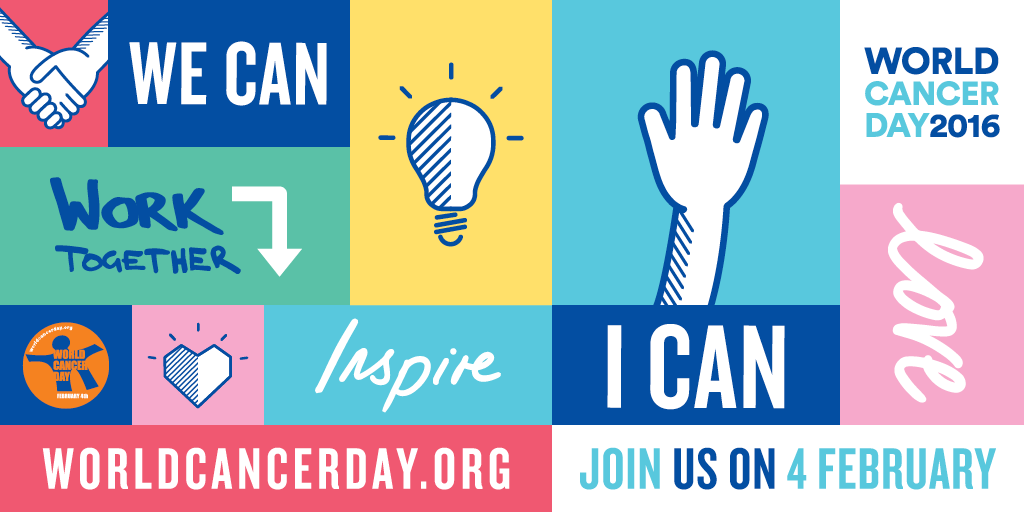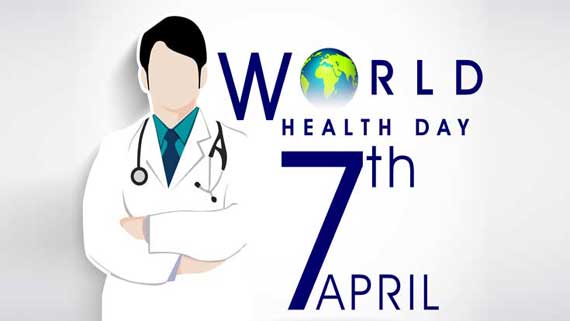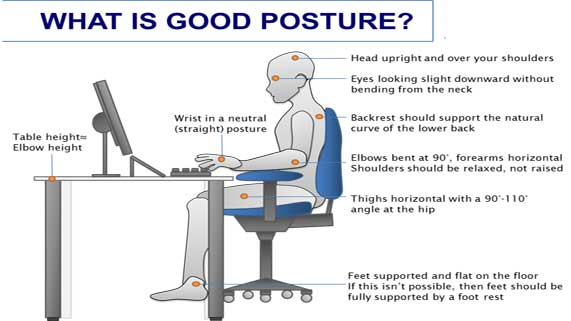February 4th is World Cancer Day – a day to reflect, plan and act on visions for cancer control. The initiative is lead by the Union for International Cancer Control (UICC) who have invited organizations, institutions, communities and people who care about cancer in every part of the world to spread the word and raise the profile of cancer in people’s minds. Taking place under the tagline ‘We can. I can.’, World Cancer Day 2016-2018 will explore how everyone – as a collective or as individuals – can do their part to reduce the global burden of cancer. Just as cancer affects everyone in different ways, all people have the power to take various actions to reduce the impact that cancer has on individuals, families and communities.
World Cancer Day is a chance to reflect on what you can do, make a pledge and take action. Whatever you choose to do ‘We can. I can.’ make a difference to the fight against cancer. On World Cancer Day, we have an opportunity to collectively examine cancer control strategies to identify winning formulas that will accelerate progress. The goal for all of us is to ensure fewer people develop cancer, more people are successfully treated and that there is a better quality of life for people during treatment and beyond.
The World Health Day is celebrated by the people all across the world every year on 7th of April under the leadership of World Health Organization to draw the mass people attention towards the importance of global health. World Health Assembly was held first time in the year 1948 in Geneva by the WHO where it was decided to celebrate the World Health Day annually on 7th of April. It was first celebrated worldwide in the year 1950 as the World Health Day. Varieties of events related to the particular theme are organized on the international and national level by the WHO.
World Health Day targets all the health issues on global basis for which several programs are organized yearly by the WHO and other related health organizations at various places like schools, colleges and other crowd places. It is celebrated to remember the establishment of the World health Organization as well as draw the attention of people towards the major health issues in the world.Disease spreading vectors like mosquitoes (malaria, dengue fever, filaria, chikungunya, yellow fever and etc), ticks, bugs, sand flies, snails and etc are also spotlighted by the WHO to make the world free from a wide range of diseases caused by parasites and pathogens. It provides better prevention and cure from the vector-borne diseases spread by vectors and travelers from one country to other.
Ergonomics (or human factors) is the scientific discipline concerned with the understanding of interactions among humans and other elements of a system, and the profession that applies theory, principles, data and methods to design in order to optimize human well-being and overall system performance.
Practitioners of ergonomics and ergonomists contribute to the design and evaluation of tasks, jobs, products, environments and systems in order to make them compatible with the needs, abilities and limitations of people. Ergonomics is a science-based discipline that brings together knowledge from other subjects such as anatomy and physiology, psychology, engineering and statistics to ensure that designs complement the strengths and abilities of people and minimize the effects of their limitations. Rather than expecting people to adapt to a design that forces them to work in an uncomfortable, stressful or dangerous way, ergonomists and human factors specialists seek to understand how a product, workplace or system can be designed to suit the people who need to use it.
Stress is what you feel when you have to handle more than you are used to. When you are stressed, your body responds as though you are in danger. It makes hormones that speed up your heart, make you breathe faster, and give you a burst of energy. This is called the fight-or-flight stress response.
Some stress is normal and even useful. Stress can help if you need to work hard or react quickly. For example, it can help you win a race or finish an important job on time.
But if stress happens too often or lasts too long, it can have bad effects. It can be linked to headaches, an upset stomach, back pain, and trouble sleeping. It can weaken your immune system, making it harder to fight off disease. If you already have a health problem, stress may make it worse. It can make you moody, tense, or depressed. Your relationships may suffer, and you may not do well at work or school.The good news is that you can learn ways to manage stress. To get stress under control:
Find out what is causing stress in your life.
Look for ways to reduce the amount of stress in your life.
Learn healthy ways to relieve stress and reduce its harmful effects.
Increasing excise taxes on cigarettes and restricting where they can be smoked in public through smoke-free air (SFA) laws are known to reduce smoking, and some, but not all, research has suggested that these same measures may have an effect on alcohol use as well. To study this question and clarify whether the effects are limited to certain beverages, a team of researchers at Washington University School of Medicine modeled per capita consumption of total alcohol and specific alcoholic beverages (beer, wine, spirits) in each U.S. state as a function of cigarette price per pack and SFA policies in each state, across nearly three decades (1980-2009). They found that raising cigarette prices, stricter SFA laws, or both were associated with significantly diminished total alcohol consumption and with lower beer and spirits consumption, but not lower wine consumption; cigarette price had a stronger impact in the first half of the study period, while SFA laws had a greater impact in the second half. Both environmental factors and genetics are associated with alcoholism with about half the risk attributed to each. A person with a parent or sibling with alcoholism is three to four times more likely to be alcoholic themselves. Environmental factors include social, cultural, and behavioral influences





